
This page created 1 January, 2003 and last modified: 23 September (52.8-9 entries' translations amended)

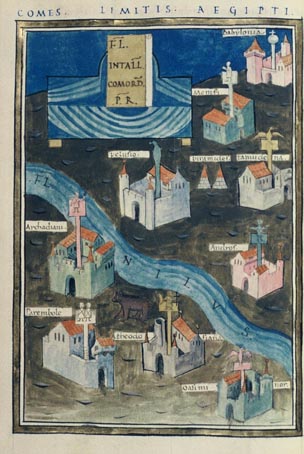 Frontpiece from the Bodleian manuscript (O). The stations depicted are: Babylonia, Memfi, Pelusio, Thamudena, Archadiana, Andros, Parembole, Theodosiana, and Oasi minor; "Pyramides" is also labelled above two pyramids, between Pelusio and Thamudena. Note that Thamudena does not appear to have a corresponding unit allocated to it in the textual list. |
The following units or detachments of units are listed as being under the command of the Count of the Egyptian Border (the numbers in front of the names refer to Ingo Maier's numbering scheme):
52.2 Legio quinta Macadonica, at Memfialong with the following units "from a lesser register": 52.12 Ala tertia Arabum, at Thenenuthiand the following units or detachments of units in Provinciae Augustamnicae: 52.26 Ala secunda Ulpia Afrorum, at Thaubasteos |
Seeck (OR.XXVIII.18) bracketed the "Thebaidos" in Legio tertia Diocletiana Thebaidos for deletion; I have no idea why; this unit is clearly a detachment from the bulk of the legion which is indeed stationed in the Thebaidos (at three separate stations, no less)...
The ala quinta praelectorum stationed at Dionisiada (52.22) is mentioned in a mid-4th century papyrus dictated by one Abinnaeus, its commanding prefect, who also mentions that he served 33 years in the vexillatione Parthusagittoriorum degentium Diospoli; i.e. the Equites sagittarii indigenae listed (56/7.6) in the Notitia as being the stationed at Diospoli under the Dux Thebaidos. This is an example, rather commonly encountered, of a limitanei unit named in the Notitia proving to have a having a longer name in another source (see T.D. Barnes, The Career of Abinnaeus, Phoenix 39.4 (1985), p 368-374, and also D. Woods (2001); 'Some Eunapiania'; in Eklogai: studies in honour of Thomas Finan and Gerard Watson; Ed. K McGroarty; NUI Maynooth, at page 92, note 26).
Ala secunda Assyriorum (52.21) might to be a mistake for Ala tertia Assyriorum, which is known from papyri to have been stationed at Sosteos; while no such Ala secunda Assyriorum is known outside the Notitia (see below).
Legio secunda Traiana is (part of) the old Legio II Traiana Fortis Germanica, and (part of) which is also listed (56.7.13) under the Dux Thebaidos, as is Legio III Diocletiana (Thebaidos; 56.7.12) and which also has a detachment listed (18.15) under the Magister Militum per Thracias. Likewise Legio V Mac[e]donica has a detachment (15.16) under the Magister Militum per Orientem, and Legio XIII gemina has a detachment (18.16) under the Magister Militum per Thracias. All this is apparently a result of Theodosius having mixed up northern troops with the Egyptian garrisons both in Egypt and in Macedon/Thrace, as recorded by Zosimus (IV.30-31). Presumably this included detachment(s) from Legio II Traiana Fortis Germanica, though they are less obvious in the Notitia. One might be the Secundani (21.19) under the Magister Militum per Illyricum.
The shield patterns as shown in the Paris manuscript (P) of the obvious detachments under the Magistri are given below:
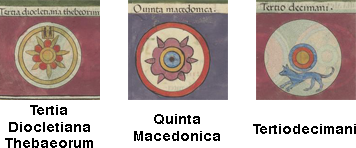
These are unlikely to be the same as those borne by the detachments still under the Comes limitis Aegypti, however, as the evidence points to these patterns being assigned when the units arrived in Europe after having left Egypt: see under here, for example.
A. M. Kaiser has recently (2014) conducted an analysis of the papyrological evidence for the Egyptian units mentioned in the Notitia: "Egyptian Units and the reliability of the Notitia dignitatum, pars Oriens", available here, which demonstrates the reliability of the Egyptian listings, and by inference, those of other eastern sections of the Notitia. She notes the following units under the Comes limitis Aegypti are attested in papyri as being mentioned by name, along with their station:
Legio quinta Macadonica, at Memfithe following units are mentioned by name, but without their station:
Ala tertia Assyriorum, at Sosteos ("secunda" in the manuscripts; see above)
Ala quinta Praelectorum, at Dionisiada (see commentary above);
Ala Arcadiana (given in the Notitia as nuper constituta, i.e. recently stationed)while the following military stations are mentioned, but not the explicit name of the unit stationed there:
Cohors prima Augusta Pannoniorum (at Tohu in the Notitia);
Scenae extra Geras (station of Ala prima Herculia)In addition, detachments of Legio quinta Macadonica, in the Notitia stationed at Memfi under the Comes limitis Aegypti, are attested in papyri, not only there, but also in places in the Thebaid such as Philadelphia and Oxyrhynchos.
Terenuthis (i.e. Thenenuthi, station of Ala tertia Arabum)
Babilona (i.e. station of Legio tertiadecima gemina)
Scenae mandrae (i.e. Scenas Mandorum, station of Ala septima Sarmatarum)
Narmunthi (station of Cohors quarta Numidarum)
Thmonepsi (i.e. Thinunepis, station of Ala prima Tingitana)
Hipponos (station of Ala Apriana).
Below are shown the frontpieces from the Parisian manuscript, P; and the Froben printed edition, B:
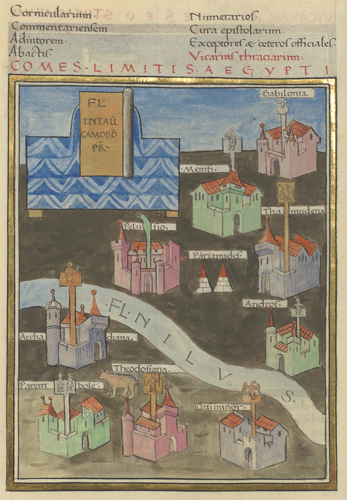
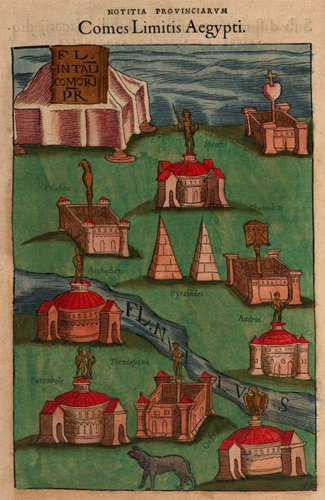
And below are shown the frontpieces from the first set of pictures in the Munich manuscript, M; and the second set, W.
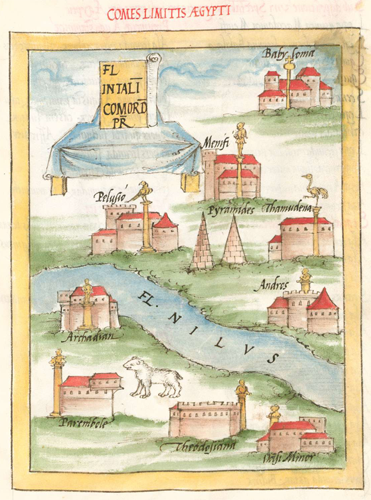
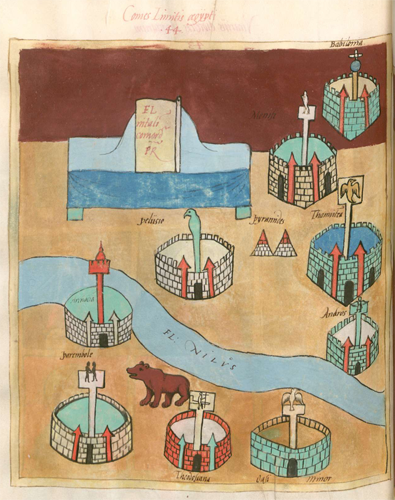
Uniquely among the illustrations in the Notitia, the towns/forts of the Comes limitis Aegypti section have what appear to be decorated poles bearing arising from inside the forts. Those of the Bodleian manuscript (O) are illustrated in detail below:
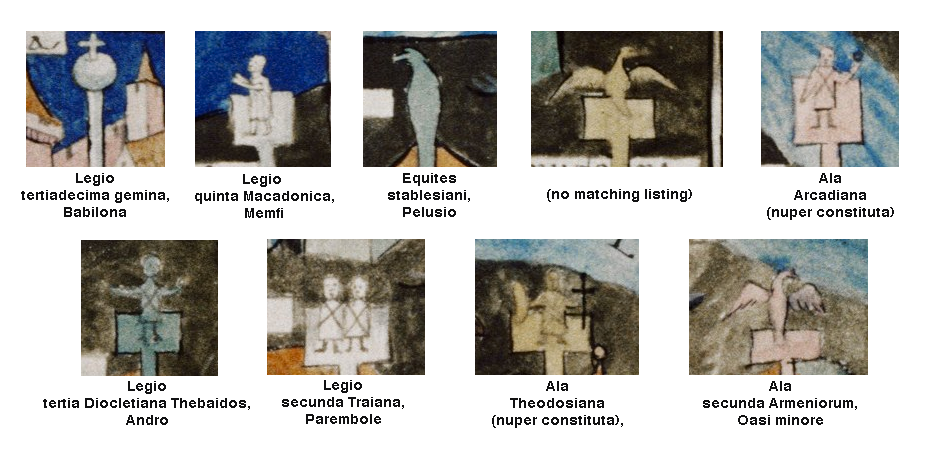
The two depicting birds with outstretched wings appear remarkably similar to aquila (Eagle) standards; and those depicting human figures look like those of imago (Imperial portrait) standards. If these do indeed depict unit standards, then that ascribed to the fortress of Babilona, and thus presumably belonging to Legio tertiadecima gemina would be of a remarkable character: that of a globus cruciger, as the earliest datable image I am aware of of such a globe surmounted by a cross is from a coin of Theodosius II of 423 (coins of his father Arcadius, who died in 408, show orbs surmounted by winged Victories rather than crosses). The figures ascribed to Theodosiana bears a cross; this, along with the previously-mentioned cross-bearing orb, appear to be the only illustrations of obviously Christian crosses in the Notitia (a potential further candidate might be the small cross surmounting the crescent of the Matiarii iuniores; 9.24).

Return to the Notitia index page.